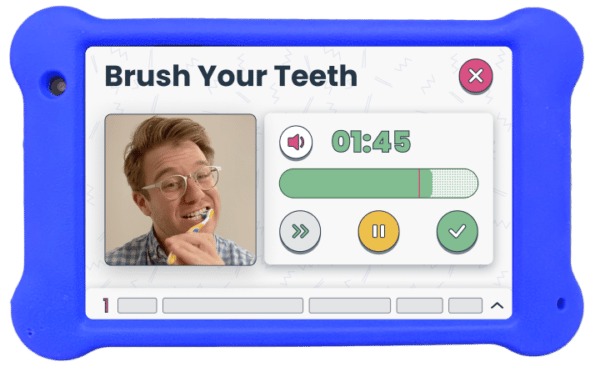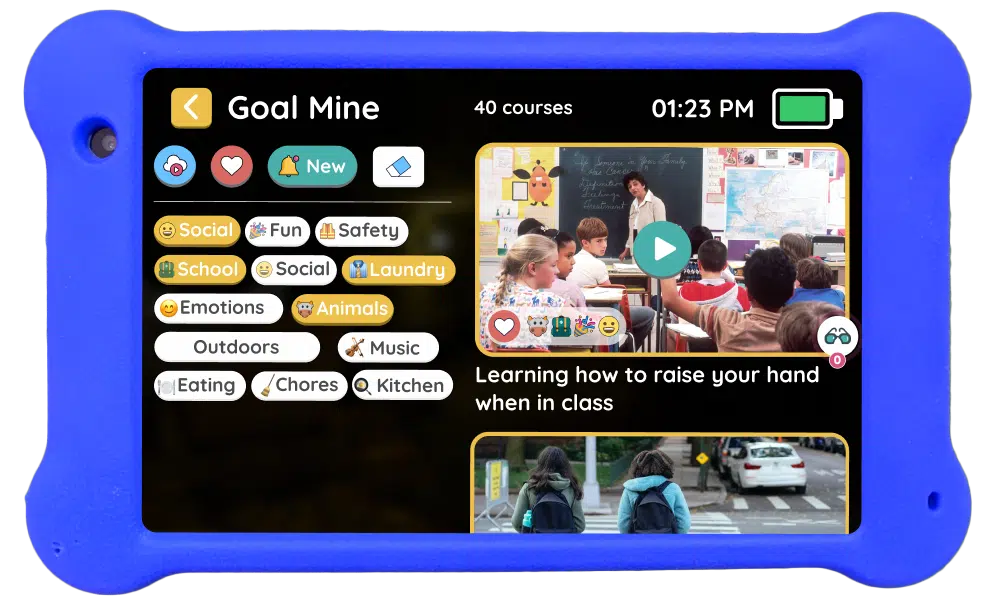So, your autistic child won’t brush teeth, and you’re at your wit’s end. We understand that toothbrushing can be a real challenge for many parents, particularly when it comes to neurodivergent kids. In this post, we’ll look into the reasons behind these struggles and provide practical solutions to help your child embrace toothbrushing. From sensory-friendly toothbrushes to engaging apps like Goally, we’ve got your back. Let’s work together to make toothbrushing a positive experience for your child.
Table of Contents
Understanding the Struggles
First and foremost, it’s crucial to comprehend why your child may resist toothbrushing. For kids with autism, the process can be overwhelming due to sensory sensitivities, anxiety, or difficulty understanding the purpose. Here are some common reasons:
- Sensory overload: The taste, texture, or smell of toothpaste, the feeling of bristles, or the sound of brushing can be too much for some kids.
- Anxiety: Fear of pain or discomfort can make toothbrushing a daunting task.
- Routine disruption: Autistic children often thrive on routine, and introducing toothbrushing can disrupt their established patterns.
Now that we’ve identified the potential causes, let’s explore some solutions to help your child overcome these toothbrushing struggles.
Sensory-Friendly Toothbrushing Tools
To help your child overcome sensory challenges, consider investing in sensory-friendly toothbrushing tools. For example:
- Soft-bristled toothbrushes: These can be gentler on sensitive gums and teeth.
- Silicone toothbrushes: They offer a softer, more flexible alternative to traditional toothbrushes.
- Flavor-free toothpaste: This can help if your child dislikes strong flavors or smells.
- Visual timers: These can provide a clear visual cue for how long to brush, reducing anxiety.
Using these tools in combination with a consistent routine can help your child feel more comfortable with toothbrushing. Moreover, Goally offers a visual timer feature that can be particularly helpful for kids with autism.
Creating a Positive Environment
A positive environment can make a world of difference for kids with thinking and learning differences. Here are some tips to create a toothbrushing-friendly space:
- Use a step stool: Ensure your child can comfortably reach the sink and see themselves in the mirror.
- Choose a calming color scheme: Opt for soothing colors like blue or green to create a relaxing atmosphere.
- Play soft music: Gentle background music can help drown out the sound of brushing and provide a calming effect.
- Provide visual cues: Use a visual schedule or social story to help your child understand the toothbrushing process.

By creating a calming and supportive environment, you can help your child feel more at ease during toothbrushing sessions.
Engaging Apps and Games
Incorporating technology can make toothbrushing more engaging for neurodivergent kids. There are several apps and games designed to make the process fun and interactive:
- Brush DJ: This app plays two minutes of music from your child’s playlist, making toothbrushing a dance party.
- Disney Magic Timer: Featuring popular Disney characters, this app encourages kids to brush for the recommended two minutes.
- Toothsavers: In this game, kids save fairy tale characters by brushing away the evil sorceress’s cavities.
Additionally, Goally offers customizable routines and rewards to help motivate your child during toothbrushing sessions.
Gradual Introduction and Positive Reinforcement
Introducing toothbrushing gradually and using positive reinforcement can help your child feel more comfortable with the process. Here’s how:
- Start with a dry toothbrush: Let your child explore the toothbrush without toothpaste to become familiar with the texture.
- Add toothpaste: Once comfortable, introduce a small amount of toothpaste and gradually increase as tolerated.
- Use a reward system: Offer praise, stickers, or small rewards for successful toothbrushing sessions.
- Be patient: Remember that progress may be slow, but consistency and patience are key.

Using Goally’s built-in reward system can further support your child’s progress and encourage consistent toothbrushing habits.
Collaborate with Professionals
If your child continues to struggle with toothbrushing, consider seeking professional help. A pediatric dentist, occupational therapist, or autism specialist can offer tailored advice and strategies to support your child’s specific needs.
Working with professionals can provide valuable insights and help you develop a customized approach to toothbrushing that meets your child’s unique requirements.
Goally | Fun Learning Videos for Kids
Looking for a way to teach those important life skills? Goally’s skill building tablet for kids includes a TV app that has a wide variety to skills training videos for kids, including “How to Brush Your Teeth” to “How to Make Friends at School” and everything in between. Designed specifically for kids, the TV app uses video modeling to teach kids all the necessary big (and little) tips and tricks to life.

Dive into the Goal Mine channel, where Puffy the Penguin leads your child through skills training videos. They’ll learn social, hygiene, and living skills that are key to their independence.
The Chill Zone channel offers low stimulation video content with Paulie the Penguin at the beach, perfect for relaxation and self-regulation.
Try our distraction-free device (with ONLY Goally apps on it) for $149. And by distraction-free, we mean your kiddo won’t be sneaking onto Youtube every few minutes… 😉
Final Thoughts | My Autistic Child Won’t Brush Teeth
Overcoming toothbrushing struggles for kids with autism may require creativity, patience, and persistence. By understanding the challenges, using sensory-friendly tools, creating a positive environment, and incorporating engaging apps like Goally, you can help your autistic child won’t brush teeth embrace toothbrushing as part of their daily routine. And remember, you’re not alone in this journey – reach out to professionals and fellow parents for support and advice. Together, we can make toothbrushing a more enjoyable experience for our neurodivergent kids.
This post was originally published on 12/28/2020. It was updated on 06/14/2023.

Goally
We help parents teach their kids life skills, like doing bedtime and morning independently. Backed by science, we incorporate evidence-based practices and expert-informed designs in all of our apps and content.






